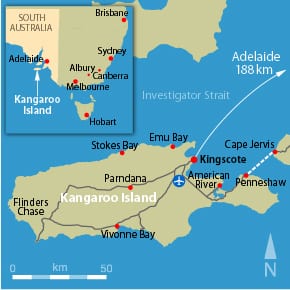It may seem a brave call given the problems facing Tasmania and the energy crisis brought about the loss of its connection to the mainland grid, but Kangaroo Island and its electricity provider are considering cutting their own connection to the mainland.
The cable linking Australia’s third biggest island – with a population of 4,500 people, and a lot of tourists – is 23 years old and its owner, South Australia Power Networks, fears it is at the end of its 30-year working life and could fail sometime in the near future.

So it is considering building a new one. But before it does, it is asking if anyone has a better idea: i.e. to find a means – likely via renewable energy such as solar and wind, along with battery storage – to cut the connection altogether.
That SAPN is considering such a move is not surprising. It has long said that it would make sense for remote communities to operate as a mini-grid with a small, or even no connection to the main network.
The issue with Kangaroo Island is that decision needs to be made soon, and the question for SAPN and other service providers is if those alternatives are ready to deliver such a service with the same reliability, and with reduced costs, than the current 15km, 33,000 volt undersea cable link.
There is clearly a lot of interest. SAPN says it has received 60 expressions of interest from parties with varying alternatives and it is now seeking formal proposals. The difference between this and Tasmania is that Kangaroo Island will ensure it has enough local generation sources, unlike Tasmania.
SAPN says it has $45 million to spend on the project, that is what the regulator has allowed, so any proposal that can beat that cost, and maintain reliability, will be seriously considered.
Kangaroo Island is currently served by the cable and a back-up 6MW diesel generator at the main town of Kingscote. About one-quarter of the 3,000 homes already have rooftop solar, and there are two larger installations of 14kW at the council chambers and 50kW at the airport (both used to help power the island’s electric vehicles).
Average load is currently around 3.5MW, with a peak load of just under 8MW (although more if rooftop solar is included, see graph above, the red line includes rooftop solar output), but this is forecast to rise to around 13MW by 2030.

Analysts suggest that expanding the solar, and combining that with battery storage to create a virtual power plant is an obvious potential solution. This could use the diesel generators or the existing cable as a back-up in the case of catastrophic failure.
Its advantage would be to cut the carbon footprint of an island that prides itself on being presented as an eco-tourist destination.
SAPN says it options must be able to supply peak electricity demand on Kangaroo Island with adequate redundancy, frequency and voltage control and be expandable to cater for any unforeseen customer demand increases, such as increases in tourist numbers.
“We’ve already got a large number of parties who have registered their interest to submit proposals,” says SAPN spokesman Paul Roberts.
“We expect a non-network solution may involve some combination of solar, battery storage, wind power and back up diesel generation. While acknowledging the challenge for proponents, it will be exciting to see whether there is a viable proposal that delivers better value for KI customers than the network solution.
Formal submissions are required from proponents by mid-July with a view to a final decision being made by the end of 2016. SA Power Networks will concurrently seek formal quotations for the supply and installation of the proposed cable to enable a direct comparison with any non-network proposals.
“While we have proposed to replace the cable, we are required to undertake a Regulator-driven process to review potential alternatives. This is aimed at testing whether there are cost efficient alternatives to network investment,” Roberts says.
“A key driver in selecting the most appropriate solution is an economic assessment based on the life of the asset; its long-term costs – including up front capital and operating/maintenance costs; and the ability to deliver high levels of reliability for an extended period.
“Any new local embedded generation option, by itself or in combination with other options, will be required to operate 24/7 and be capable of meeting all of Kangaroo Island’s needs for the next 25 years.”









